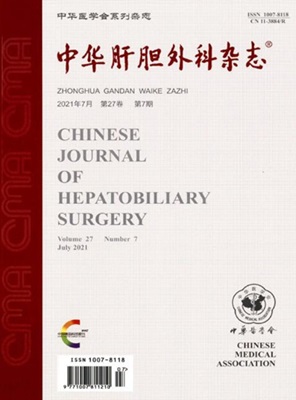Use of microwave scalpel in hepatectomy for hepatocellular carcinoma
Q4 Medicine
引用次数: 0
Abstract
Objective To study the clinical use of microwave scalpel in hepatectomy for hepatocellular carcinoma without hepatic vascular inflow occlusion. Methods A retrospective study was conducted on the clinical data of 126 consecutive patients with hepatocellular carcinoma who were treated at the Department of Hepatobiliary Surgery of the Third Affiliated Hospital of Sun Yat-sen University from December 2015 to August 2018. The patients included 111 males and 15 females, with ages which ranged from 25 to 75 years. These patients were divided into two groups by the different surgical resection methods: the microwave scalpel hepatectomy (MSH) group which employed microwave scalpels to perform hepatectomy (n=42), and the ultrasound scalpel hepatectomy (USH) group which employed ultrasound scalpels (n=84). The perioperative conditions which included baseline data, amount of intraoperative bleeding, liver function after operation, and morbidity of postoperative complications were compared. Results There were no significant differences in the preoperative indexes which included tumor diameter, number of tumors, levels of aspartate aminotransferase (AST) and alanine aminotransferase (ALT) between the 2 groups (all P>0.05). In the MSH group, the amount of intraoperative bleeding was 100.0 (100.0, 200.0) ml, which was significantly lower than the 300.0 (100.0, 400.0) ml in the USH group (P<0.05). Compared with the USH group, the levels of AST and ALT on postoperative day 1, 3, 7 after operation in the MSH group were significantly lower (all P<0.05), and the corresponding albumin levels were significantly higher than the USH group (P<0.05). The incidence of complications was 4.8%(2/42) in the MSH group which was significantly lower than that of 20.2%(17/84) in the USH group (P<0.05). Conclusion Microwave scalpel significantly reduced intraoperative bleeding and postoperative complications, and led to less liver functional injury. Key words: Carcinoma, hepatocellular; Hepatectomy; Microwave scalpel; Ultrasound scalpel; Intraoperative bleeding; Liver function微波刀在肝癌肝切除术中的应用
目的探讨微波刀在无肝血管流入阻塞的肝癌肝切除术中的临床应用。方法回顾性分析中山大学第三附属医院肝胆外科2015年12月至2018年8月连续收治的126例肝细胞癌患者的临床资料。患者男111例,女15例,年龄25 ~ 75岁。根据手术切除方式的不同,将患者分为两组:微波手术刀肝切除术(MSH)组(42例)和超声手术刀肝切除术(USH)组(84例)。比较两组围手术期情况,包括基线资料、术中出血量、术后肝功能、术后并发症发生率。结果两组患者术前肿瘤直径、肿瘤数目、谷草转氨酶(AST)、丙氨酸转氨酶(ALT)水平比较,差异均无统计学意义(P < 0.05)。MSH组术中出血量为100.0 (100.0,200.0)ml,明显低于USH组3000.0 (100.0,400.0)ml (P<0.05)。与USH组比较,MSH组术后第1、3、7天AST、ALT水平均显著降低(均P<0.05),相应白蛋白水平显著高于USH组(P<0.05)。MSH组并发症发生率为4.8%(2/42),明显低于USH组的20.2%(17/84)(P<0.05)。结论微波手术刀可明显减少术中出血和术后并发症,减少肝功能损伤。关键词:肝癌;肝细胞癌;肝切除术;微波手术刀;超声手术刀;术中出血;肝功能
本文章由计算机程序翻译,如有差异,请以英文原文为准。
求助全文
约1分钟内获得全文
求助全文
来源期刊

中华肝胆外科杂志
Medicine-Gastroenterology
CiteScore
0.20
自引率
0.00%
发文量
7101
期刊介绍:
Chinese Journal of Hepatobiliary Surgery is an academic journal organized by the Chinese Medical Association and supervised by the China Association for Science and Technology, founded in 1995. The journal has the following columns: review, hot spotlight, academic thinking, thesis, experimental research, short thesis, case report, synthesis, etc. The journal has been recognized by Beida Journal (Chinese Journal of Humanities and Social Sciences).
Chinese Journal of Hepatobiliary Surgery has been included in famous databases such as Peking University Journal (Chinese Journal of Humanities and Social Sciences), CSCD Source Journals of China Science Citation Database (with Extended Version) and so on, and it is one of the national key academic journals under the supervision of China Association for Science and Technology.
 求助内容:
求助内容: 应助结果提醒方式:
应助结果提醒方式:


